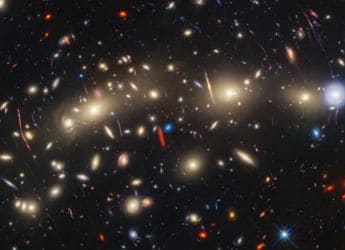- Home
- Social networking
- Social networking News
- 3D Printed Dress Begins Exposing Skin as Wearer Shares on Social Media
3D-Printed Dress Begins Exposing Skin as Wearer Shares on Social Media

Which means that at the end of the day you might end up exposing your whole body - if you are an avid social media user.
"x.pose is a wearable data-driven sculpture that exposes a person's skin as a real-time reflection of the data that the wearer is producing," the designers behind the project, Pedro Oliveira and Xuedi Chen from New York University, were quoted as saying.
The dress is made of a 3D mesh created from location data of the user's whereabouts, gleaned from the wearer's phone. The reactive displays that change in opacity to reveal the wearer's skin are controlled by a small computer built into the back of the dress.
Chen adds, "There currently exists a paradox in our internet culture. As a generation, we are simultaneously obsessed with publicity and privacy. While we publish and post details about our lives online, at the same time we demand the most advanced privacy protection software. An unprecedented degree of potential exposure comes with the current mode of existence... I have ceded control of my data emissions and Based on my activity logs, Google clearly knows where I am, where I've been and possibly even where I'm going. Yet when I wanted a log of my location history, I had to go through numerous steps to 'enable' tracking..."
The computer constantly monitors the user's online activity. Depending on the volume of posts and other activity, panels on the dress can either flicker or become completely transparent, Daily Mail reported.
"As more data is produced and collected from the wearer, the more naked he/she will become," the developers added.
Get your daily dose of tech news, reviews, and insights, in under 80 characters on Gadgets 360 Turbo. Connect with fellow tech lovers on our Forum. Follow us on X, Facebook, WhatsApp, Threads and Google News for instant updates. Catch all the action on our YouTube channel.
Related Stories
- Samsung Galaxy Unpacked 2025
- ChatGPT
- Redmi Note 14 Pro+
- iPhone 16
- Apple Vision Pro
- Oneplus 12
- OnePlus Nord CE 3 Lite 5G
- iPhone 13
- Xiaomi 14 Pro
- Oppo Find N3
- Tecno Spark Go (2023)
- Realme V30
- Best Phones Under 25000
- Samsung Galaxy S24 Series
- Cryptocurrency
- iQoo 12
- Samsung Galaxy S24 Ultra
- Giottus
- Samsung Galaxy Z Flip 5
- Apple 'Scary Fast'
- Housefull 5
- GoPro Hero 12 Black Review
- Invincible Season 2
- JioGlass
- HD Ready TV
- Laptop Under 50000
- Smartwatch Under 10000
- Latest Mobile Phones
- Compare Phones
- Vivo Y500 Pro
- Realme GT 8 Pro Aston Martin F1 Limited Edition
- Huawei Mate 70 Air
- Moto G57
- Moto G57 Power
- Motorola Edge 70
- Moto G Play (2026)
- Moto G (2026)
- MacBook Pro 14-inch (M5, 2025)
- Asus Vivobook S16 (S3607QA)
- iQOO Pad 5e
- OPPO Pad 5
- Noise Diva 2
- Noise Halo 2
- Acerpure Nitro Z Series 100-inch QLED TV
- Samsung 43 Inch LED Ultra HD (4K) Smart TV (UA43UE81AFULXL)
- Asus ROG Ally
- Nintendo Switch Lite
- Haier 1.6 Ton 5 Star Inverter Split AC (HSU19G-MZAID5BN-INV)
- Haier 1.6 Ton 5 Star Inverter Split AC (HSU19G-MZAIM5BN-INV)

















